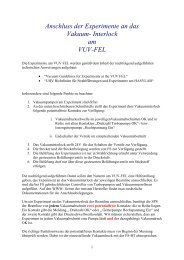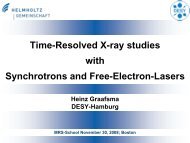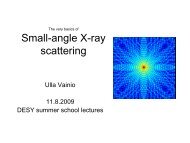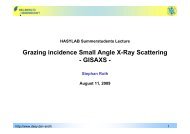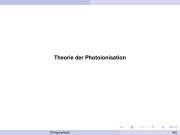The OTIS Reference Manual - Hasylab
The OTIS Reference Manual - Hasylab
The OTIS Reference Manual - Hasylab
You also want an ePaper? Increase the reach of your titles
YUMPU automatically turns print PDFs into web optimized ePapers that Google loves.
<strong>The</strong> DLL (Delay Locked Loop) is a regulated chain of 32 delay elements consisting of two stages<br />
each. Since the output of every stage is used, the theoretical bin size is 390ps ( 25ns<br />
26 ≈ 0.39ns).<br />
Furthermore, the 64 time bins require 6 bit drift time encoding per channel. <strong>The</strong> drift time data<br />
(32 × 6bit) plus hit mask (32bit), bunch crossing number (8bit) and status information (8bit) is<br />
stored in the 240 bit wide pipeline memory. <strong>The</strong> capacity of the memory is 164 words to allow<br />
a maximum latency of 160 clock cycles. If a trigger occurs, the corresponding data words are<br />
transferred to the derandomizing buffer which is able to store data from up to 16 consecutive<br />
trigger signals. <strong>The</strong> control unit’s task is to process and read out the data of each triggered event<br />
within 900ns. <strong>The</strong> read out interface is 8 bit wide and it operates synchronous to the 40MHz LHC<br />
system clock.<br />
<strong>The</strong> chip version <strong>OTIS</strong>1.1 has been submitted for manufacturing in November 2003. It features<br />
a modified TDC core to overcome the problem of missing drift time codes of chip version<br />
<strong>OTIS</strong>1.0. Other changes visible to the user include rearranged read out header bits and a modified<br />
register map. Additionally the LVDS data output pads have been replaced by differential CMOS<br />
outputs. Further modifications provide buffers for the ASD threshold voltage outputs and a new<br />
implementation of the control algorithm as well as the possibility read out triggered event data<br />
via the I2C interface.<br />
<strong>The</strong> control algorithm of chip version <strong>OTIS</strong>1.2 (submitted in May 2004) finally provides the<br />
MultiHit operation mode. Other changes with respect to its predecessor chip result in a smaller<br />
DNL figure and in a smaller offset voltage spread of the ASD threshold outputs. Compared to<br />
<strong>OTIS</strong>1.1, the chip size changed. This implicates changes in the pad positions, however the pad<br />
order did not change.<br />
Though chip version <strong>OTIS</strong>1.2 fulfills the specifications for LHCb front end electronics, the chip<br />
version <strong>OTIS</strong>1.3 has been manufactured addressing further improvements in the TDC core (Phase<br />
detector was changed; As a result, the differential non-linearity has signficantly decreased - see<br />
Sect. 7.3 and 7.4).<br />
4 Electrical Specifications<br />
4.1 DC Characteristics<br />
<strong>The</strong> <strong>OTIS</strong> chip needs two positive operating voltages: analog and digital supplies of nominal +2.5V<br />
with respect to Ground (gnd, 0V) each. <strong>The</strong> operational range of vdda and vdd is predetermined<br />
by the manufacturing process. Minimum, maximum and nominal supply voltage ratings are listed<br />
in table 1.<br />
Name Explanation Min. Typ. Max. Unit<br />
vdd, vdd * 2 Positive digital supply 2.2 2.5 2.7 V<br />
vdda Positive analog supply 2.2 2.5 2.7 V<br />
gnd Detector ground -0.2 0 0.2 V<br />
Table 1: DC characteristics of the <strong>OTIS</strong> chip<br />
All supply voltages should be thoroughly blocked against gnd (e.g. a 100nF ceramic capacitor<br />
in parallel with a 68µF tantalum capacitor between vdd/vdda and gnd). <strong>The</strong> blocking capacitors<br />
should be placed as close as possible to the chip.<br />
After powering the chip, the <strong>OTIS</strong> chip performs a power up reset (c.f. chapter 6.1). In this<br />
state the power consumption is 225mA (or 563mW). Power consumption rises to 267mA (or<br />
668mW) when operating the chip at the nominal LHC bunch crossing frequency of 40MHz and a<br />
trigger rate of 1MHz.<br />
2 any power supply net having a name starting with vdd<br />
6





